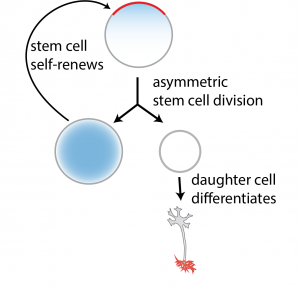We all start off as a single cell, the fertilized egg, yet we develop bodies that are comprised of hundreds of different cell types. What mechanisms exist that drive the generation of cell type diversity and what happens if cell fate specification goes wrong? These are the central questions that my lab aims at addressing.
The lab mainly uses the neural stem cells of the developing brain of the fruit fly Drosophila as a model system. These cells represent one of the best understood stem cell model systems and divide asymmetrically. This means that when they divide, instead of resulting in two cells of the same fate, two cells of different fate are produced. One daughter cell remains a stem cell, while the other daughter cell eventually specializes to become a different cell type. Our aim is to decipher the molecular mechanisms that allow cells to faithfully carry out this type of division.

When cells divide many processes need to be coordinated, this task is even more complex when the outcome of a division is asymmetric. Research in the lab aims at addressing the molecular principles behind this coordination at various levels. What signals do the cells required and how do these signals affect the internal organization of cells? We are interested in how signals from a particular class of enzymes, called kinases, that can modify and alter the behaviour of their substrates coordinate cell division and cell fate.
One outcome of such signalling can be the organisation of the distribution of substrates within cells. This can lead to the patterned or asymmetric localization of molecules in the stem cells that we study. The establishment of such subcellular patterns or polarity is important in many different cell types and context and perturbation of asymmetric division and loss of polarity bear a strong connection to several human diseases. Many of the genes so far identified to be required for these processes operate in flies as well as in man. Therefore, by studying fundamental principles of cell division, asymmetry and polarity establishment and the signals that coordinate these processes in a model system, we hope to contribute to our understanding the molecular logic of cell fate generation and its role in diseases that affect us.
Cell division is a highly dynamic process. To capture this particular aspect, the lab uses mainly, live cell imaging approaches to study asymmetric cell division, pattern formation and cell fate specification in vivo and in real time in combination with genetic approaches, laser manipulation and pharmacological approaches.
